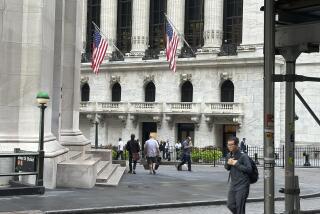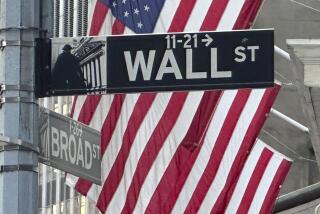Economic Indicators Plunge 1.2% in May : Decline Greatest Since 1987 Crash of Stock Market
- Share via
WASHINGTON — The government’s chief economic forecasting gauge plunged 1.2% in May, the biggest decline since the stock market crash in late 1987, the Commerce Department reported today.
The decline in the Index of Leading Economic Indicators was the third in the last four months, as the gauge designed to foretell economic activity six to nine months into the future continued to flash strong signals of a significant decline in economic activity.
The 1.2% decline was significantly steeper than analysts had been expecting. However, economists generally believe that the economy can escape a recession this year, although they are looking for a major slowing in economic growth accompanied by rising unemployment.
The 1.2% drop in May followed a 0.6% gain posted in April. The index had fallen 0.6% in March and 0.3% in February.
The May decline was the steepest since a 1.8% plunge in November, 1987. That drop reflected the shock to the economy from the 508-point plunge in the Dow Jones index of 30 industrial stocks Oct. 19, 1987.
Fed’s Efforts Blamed
The April increase had allowed the index to steer clear of the traditional signal of a forthcoming recession--three declines in a row. But the May report added to the overall downward trend this year that has worried many economists.
Today’s index figure reinforced recent government and private industry reports that show almost every sector of the economy contracting because of the Federal Reserve Board’s efforts to raise interest rates to control inflation.
For instance, only two of the 11 forward-looking business statistics that make up the composite index--higher stock prices and increased building permits--pointed upward in May.
The others pointed down: a drop in the money supply; lower prices for sensitive materials, indicating slower demand; the fourth consecutive drop in an index measuring consumer confidence; faster vendor deliveries, meaning declining demand; a shorter average workweek; fewer orders for plants and equipment; a decrease in manufacturers’ unfilled orders; higher initial claims for jobless benefits; and a decrease in manufacturers’ unfilled orders.
Some Fear Recession
The Fed has relaxed its grip slightly, but the effects remain. Some economists fear that, unless the central bank eases more, the economy could be pushed into a recession.
“We’re still looking for a soft landing without a recession, but we’re keeping our fingers crossed,” said David Wyss, senior financial economist at Data Resources Inc., in Lexington, Mass.
Lawrence Chimerine, senior economic adviser for the WEFA Group in Bala Cynwyd, Pa., said, “I still think we’ll avoid a recession, but the data probably is a little weaker than any of us had expected.”
In advance of today’s report, most economic forecasters were predicting that the index would give up its April gain--if not more.
But they thought that the economy, now in its seventh year of expansion, would continue to grow, although slightly, this year.
Chimerine described 1989 as a “transition into a long period of fairly slow growth,” somewhere between 1% and 2%.
More to Read
Inside the business of entertainment
The Wide Shot brings you news, analysis and insights on everything from streaming wars to production — and what it all means for the future.
You may occasionally receive promotional content from the Los Angeles Times.










